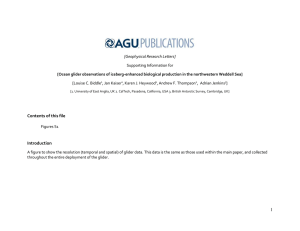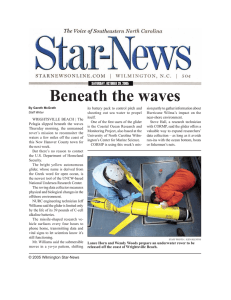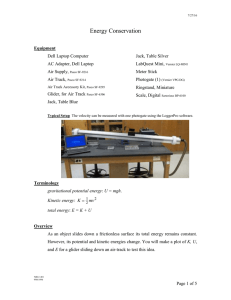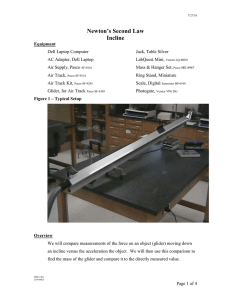Energy Conservation
advertisement
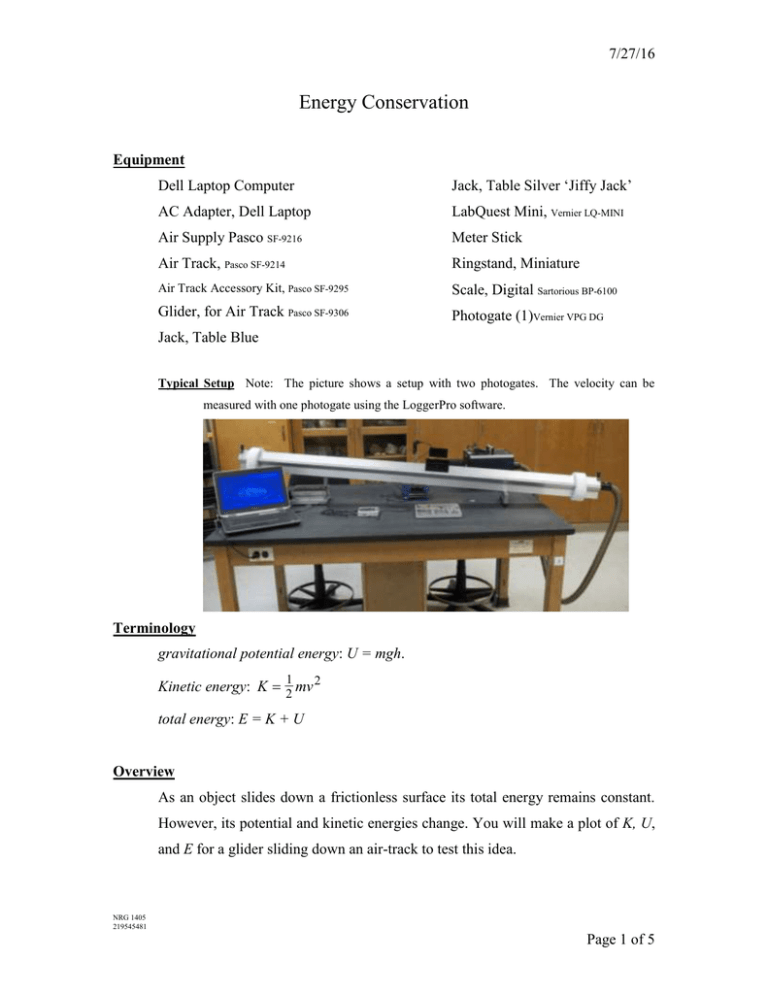
7/27/16 Energy Conservation Equipment Dell Laptop Computer Jack, Table Silver ‘Jiffy Jack’ AC Adapter, Dell Laptop LabQuest Mini, Vernier LQ-MINI Air Supply Pasco SF-9216 Meter Stick Air Track, Pasco SF-9214 Ringstand, Miniature Air Track Accessory Kit, Pasco SF-9295 Scale, Digital Sartorious BP-6100 Glider, for Air Track Pasco SF-9306 Photogate (1)Vernier VPG DG Jack, Table Blue Typical Setup Note: The picture shows a setup with two photogates. The velocity can be measured with one photogate using the LoggerPro software. Terminology gravitational potential energy: U = mgh. 1 Kinetic energy: K 2 mv 2 total energy: E = K + U Overview As an object slides down a frictionless surface its total energy remains constant. However, its potential and kinetic energies change. You will make a plot of K, U, and E for a glider sliding down an air-track to test this idea. NRG 1405 219545481 Page 1 of 5 7/27/16 Introduction When the non-conservative (frictional) work on an object is zero, its total energy remains constant. This is a fundamental tenet of science and has extremely broad application in all technical fields. The two types of energy we will consider are the gravitational potential energy U, and the kinetic energy K, both for our air-track glider. Since there are no other energies relevant for the glider, the sum of these two energies will be its total energy E. You will make measurements of U and K for five different locations on the airtrack that the glider will pass over. U mgh mass of the glider. This can be found by weighing the glider on the electronic scale on the side board. This is the acceleration due to gravity. height relative to a reference point. In this lab the reference point will be the 0.3m measurement on the air track. At the 0.3m point . All other marks are measured relative to the 0.3m point. In Figure 1 they are denoted by showing their relation to the 0.3m point. mass of the glider. This can be found by weighing the glider on the electronic scale on the side board. v is the velocity taken by the photogate at each point on the air track. (0.3m, 0.6m, 0.9m, 1.2m, and 1.5m) It should be noted that at the 1.5m point. The flag is centered on the glider so that in effect we are considering all the mass to be located at the center of the glider. As the flag passes through the photogate LoggerPro can calculate its speed. The center of the glider is where all references are taken. NRG 1405 219545481 Page 2 of 5 7/27/16 Once this data is collected you will plot the three quantities U, K, and (K + U) versus the position of the glider on the track. This plot will allow you to test the idea of energy conservation as it applies to our simple glider, air-track system. Figure 1 150cm 120cm 90cm h h h 60cm h 30cm Air Track Table Accuracy All of your observations should be recorded to 3 significant figures. You should carry 3 significant figures in all of your calculations as well. Procedure 1. Set the silver jack to approximately 10cm in height. Set up the air-track using the silver jack under the single leg. The foot should rest in the hole on top of the jack. 2. Weigh the glider w/flag on the electronic scale located on the side board. Enter the value on the data page. 3. Determine the values for h at each of the points on the air track. Enter values in Table 1. (Remember at the 0.3m point on the track.) 4. Calculate the potential energy U at each of the points and enter in Table 1 5. Set up the photogate and the LabQuest Mini interface to the computer and start LoggerPro3.x. The file will have the path File\Open\Probes & Sensors\Photogates\One Gate Timer.cmbl 6. Set the photogate at the 0.3m point and start data collection in LoggerPro. NRG 1405 219545481 Page 3 of 5 7/27/16 7. Release the glider from the 1.50m point and record the velocity from LoggerPro. You will see that this will be the fastest velocity of all the data runs. 8. Move the photogate to the 0.6m point and release the glider from the 1.5m point. If necessary, you can use the blue jack to raise the photogate sufficiently to clear the flag on the glider. 9. Continue this process (moving the photogate) until you get the photogate to the 1.5m point on the air track. At this point you can enter a velocity of 0.0m/s. Data and Analysis Mass of the glider Location Height h (m) m = __________________ (units and 3 sig. fig.) v (J) (J) ( ) (J) 0.3m 0.0m 0.6m 0.9m 1.2m 1.5m 0.0J After filling out this entire table you are ready to make your graph. The vertical scale will be energy in joules and the horizontal scale should be position in meters e.g. 0.30, 0.60, 0.90 m, 1.2m and 1.5m (it should be in SI units). Draw best-fit lines for each quantity, U, K, and E for your graph. Your finished graph should resemble Figure 2. NRG 1405 219545481 Page 4 of 5 7/27/16 Figure 2 Questions 1. Is the best-fit line for the total energy E horizontal? 2. Should the best-fit line for E be horizontal? Explain why or why not. NRG 1405 219545481 Page 5 of 5
